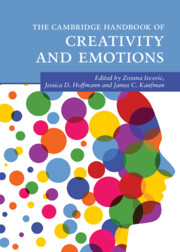Book contents
- The Cambridge Handbook of Creativity and Emotions
- Cambridge Handbooks in Psychology
- The Cambridge Handbook of Creativity and Emotions
- Copyright page
- Dedications
- Contents
- Figures
- Tables
- Contributors
- Acknowledgments
- Creativity and Emotions
- Part I Methods in the Study of Creativity and Emotions
- 1 Experimental Methods in the Study of Emotions and Creativity
- 2 Affect, Complexity, and the Case Study Method
- 3 Observational Methods in the Study of Creativity and Emotions
- 4 Assessing Creativity and Affect in Everyday Environments
- Part II The Development of Creativity
- Part III Emotions and the Creative Person
- Part IV Emotions and Creative Products
- Part V Emotions and Creativity at School and Work
- Index
- References
1 - Experimental Methods in the Study of Emotions and Creativity
from Part I - Methods in the Study of Creativity and Emotions
Published online by Cambridge University Press: 16 February 2023
- The Cambridge Handbook of Creativity and Emotions
- Cambridge Handbooks in Psychology
- The Cambridge Handbook of Creativity and Emotions
- Copyright page
- Dedications
- Contents
- Figures
- Tables
- Contributors
- Acknowledgments
- Creativity and Emotions
- Part I Methods in the Study of Creativity and Emotions
- 1 Experimental Methods in the Study of Emotions and Creativity
- 2 Affect, Complexity, and the Case Study Method
- 3 Observational Methods in the Study of Creativity and Emotions
- 4 Assessing Creativity and Affect in Everyday Environments
- Part II The Development of Creativity
- Part III Emotions and the Creative Person
- Part IV Emotions and Creative Products
- Part V Emotions and Creativity at School and Work
- Index
- References
Summary
Creativity researchers often use experiments to better understand the relation between emotion and creativity. This requires the effective induction of emotional states and suitable measures of creativity. This chapter reviews the requirements and possibilities for the design of experiments that examine the effect of emotion on creativity. After briefly reviewing the terms affect, mood, and emotions, this chapter describes and evaluates existing affect elicitation procedures, along with general methodological considerations. This chapter also briefly discusses how the reversed link can be studied using experimental research: How creative thinking may alter affective experience. In doing so, this chapter provides methodological and practical guidelines for designing experimental research into the relation between emotion and creativity.
- Type
- Chapter
- Information
- The Cambridge Handbook of Creativity and Emotions , pp. 11 - 29Publisher: Cambridge University PressPrint publication year: 2023



